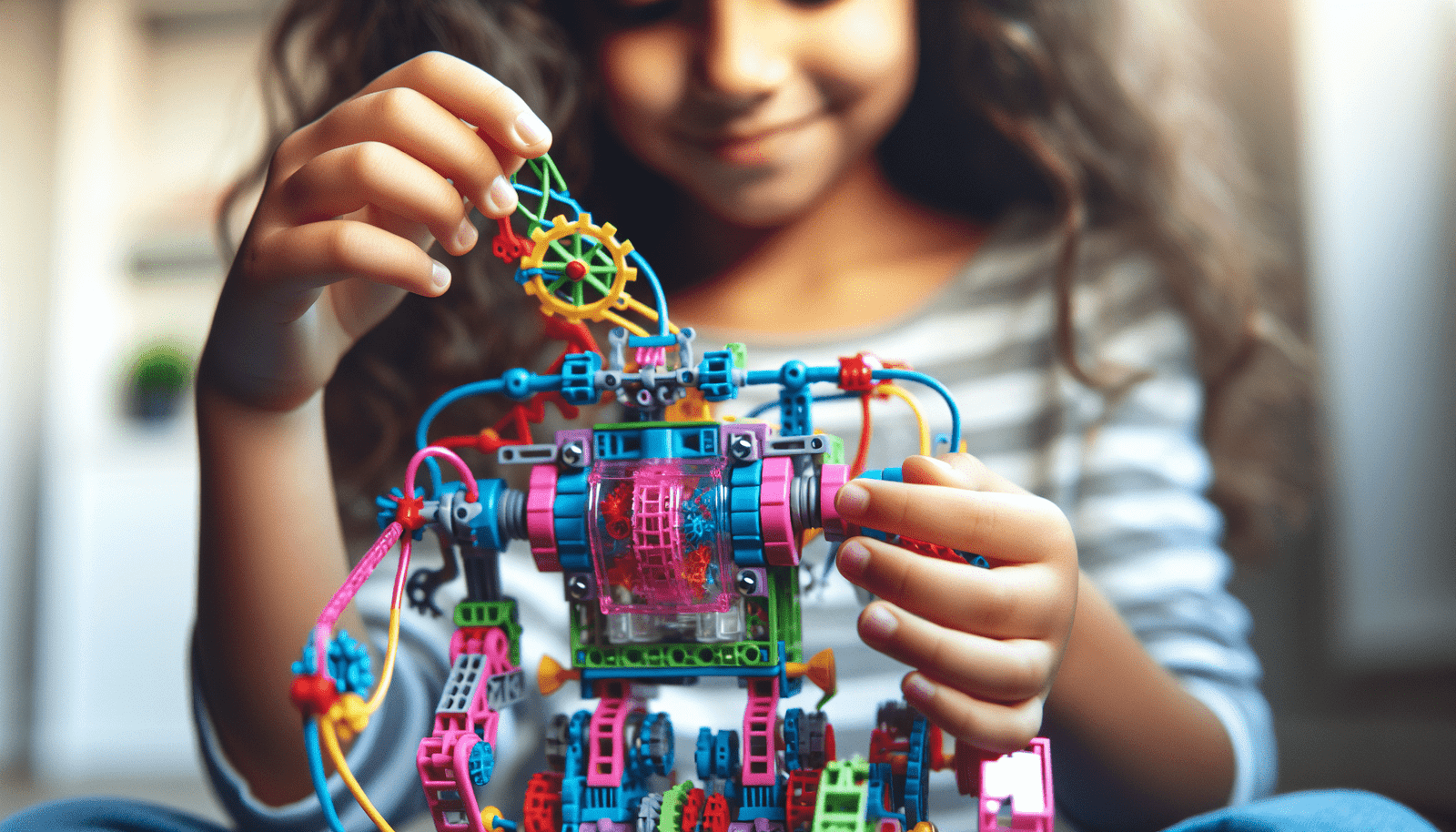Are you a parent or educator looking for ways to make learning more enjoyable and engaging for your child? Look no further than STEM toys! In this article, we will explore how you can make learning with STEM toys fun and exciting for kids. Whether you’re curious about the benefits of STEM toys or wondering how to integrate them into your child’s playtime, we’ve got you covered. Join us as we delve into the world of STEM toys and discover the endless possibilities they offer for educational and entertaining experiences. Get ready to ignite your child’s curiosity and creativity as we embark on this learning adventure together!
Learning With STEM Toys Fun And Exciting For Kids
Understanding STEM Toys
Defining what STEM toys are
STEM toys are educational toys that are designed to promote learning in the fields of science, technology, engineering, and mathematics. These toys are specifically created to engage children in hands-on play and learning experiences that stimulate their curiosity, problem-solving skills, and creativity.
Importance of STEM toys in child education
STEM toys play a crucial role in shaping a child’s education and development. By engaging in STEM play, children have the opportunity to explore and understand complex concepts in a fun and interactive way. This not only cultivates a love for learning but also helps them develop essential skills such as critical thinking, analytical reasoning, and logical problem-solving. In addition, STEM toys can also foster a deep understanding of STEM subjects, paving the way for future academic and career success.
How STEM toys can aid development and literacy in STEM fields for children
STEM toys provide children with a solid foundation in STEM subjects, preparing them for future careers in these fields. By engaging in STEM play, children develop a strong understanding of scientific principles, technology, engineering concepts, and mathematical reasoning. This early exposure and hands-on learning experiences lay the groundwork for developing literacy in STEM fields and helps children build a solid knowledge base. It also fosters the development of important skills like creativity, innovation, and collaboration, which are essential for success in today’s technologically advanced world.
Choosing the Right STEM Toys
Identifying educational value
When choosing STEM toys, it is important to look for toys that have clear educational value. Consider toys that introduce children to foundational STEM concepts, encourage problem-solving and critical thinking, and provide opportunities for creativity and experimentation. Look for toys that are designed to teach specific STEM skills or concepts, and ensure they align with your child’s interests and age level.
Considering the child’s age and interests
Different STEM toys cater to different age groups and interests. Consider your child’s age and developmental stage when selecting STEM toys. For younger children, choose toys that are designed to develop fine motor skills and engage their senses. Older children may be ready for more complex STEM toys that involve construction, building circuits, or programming robots. It’s also important to choose toys that align with your child’s interests, as this will keep them engaged and motivated to explore STEM concepts.
Looking into the toy safety standards
When selecting STEM toys for your child, it is crucial to prioritize safety. Ensure that the toys you choose meet all safety standards and have been tested for any potential hazards. Check for age-appropriate warnings, choking hazards, and toxic materials. Look for toys that are made from non-toxic materials and have been certified by reputable safety organizations.
Reading product reviews prior to purchase
Before making a purchase, take the time to read product reviews from other parents and educators. These reviews can provide insights into the quality, durability, and educational value of the STEM toys. Look for reviews that mention the toy’s ability to engage children, its durability over time, and how well it aligns with the educational goals you have in mind. Reading product reviews can help you make an informed decision and choose the best STEM toys for your child’s learning and development.
Integrating STEM Toys in Learning Process
Creating a learning schedule
To make the most of STEM toys, it is beneficial to create a learning schedule that incorporates dedicated time for STEM play. Set aside specific times during the week for your child to engage with STEM toys and activities. This will create a routine and ensure that STEM learning becomes a regular part of their daily life. Establishing a schedule also helps children develop a sense of responsibility towards their own learning and encourages them to take ownership of their educational journey.
Combining playtime and learning with STEM toys
One of the key advantages of STEM toys is that they allow children to learn while they play. Encourage your child to explore and experiment with the toys freely, giving them the freedom to discover and learn on their own terms. Let them take the lead and follow their interests, while gently guiding them towards new concepts and challenges. By combining playtime and learning, STEM toys become a fun and enjoyable learning experience for children.
Encouraging learning through curiosity and exploration
STEM toys are designed to spark curiosity and promote exploration. Encourage your child to ask questions, make observations, and conduct experiments with their STEM toys. Foster their natural curiosity by providing them with resources, such as books or online videos, that can further expand their knowledge and understanding. By encouraging curiosity and exploration, you are nurturing a love for learning and empowering your child to become an independent thinker and problem solver.
Making STEM Learning Fun with Toys
Making use of engaging ways to teach
To make STEM learning with toys fun and exciting, it is important to make use of engaging teaching methods. Incorporate storytelling, role-playing, or pretend play to create immersive experiences with the STEM toys. For example, if your child is using a coding toy, have them pretend to be a robot or a computer programmer while they engage with the toy. By making the learning experience interactive and imaginative, you can enhance your child’s engagement and enjoyment.
Organizing fun exhibitions or displays
Organize fun exhibitions or displays to showcase your child’s STEM creations and projects. This can include setting up a mini science fair at home or inviting friends and family to see what your child has learned and accomplished with their STEM toys. Display their engineering projects, science experiments, or technological creations to celebrate their achievements. This not only boosts their confidence but also instills a sense of pride in their STEM accomplishments.
Allowing room for creativity and problem-solving
STEM toys provide children with the opportunity to engage in open-ended play, where they can explore their creativity and problem-solving skills. Encourage your child to think outside the box and come up with unique solutions to challenges presented by the toys. Allow them to experiment, make mistakes, and learn from them. By giving them the freedom to be creative and problem solve, you are fostering their innovation and critical thinking abilities.
Creating challenges and hands-on competitions
To make STEM learning with toys more exciting, create challenges and hands-on competitions for your child. Set specific goals or tasks for them to accomplish using their STEM toys. For example, challenge them to build the tallest tower using a set of building blocks or program a robot to navigate through a maze. These challenges provide a sense of achievement and stimulate healthy competition, motivating your child to push their boundaries and strive for excellence.
Parental Involvement and Guidance
Actively participating in child’s play
As a parent, it’s important to actively participate in your child’s play with STEM toys. Get involved, ask questions, and show genuine interest in what they are doing. Collaborate with them on projects, offer guidance when needed, and provide encouragement and support along the way. By actively participating, you not only strengthen your bond with your child but also enhance their learning experience and foster a love for STEM education.
Explaining complex topics in simple terms
STEM concepts can sometimes be complex and challenging for children to grasp. As a parent, it is your role to explain these concepts in simple terms that your child can understand. Break down complex ideas into bite-sized pieces and use real-life examples or analogies to make them relatable. By simplifying these concepts, you make STEM learning more accessible and enjoyable for your child.
Providing positive reinforcement
Positive reinforcement is key to motivating and encouraging your child during their STEM learning journey. Celebrate their achievements, no matter how small, and acknowledge their efforts. Offer praise for their problem-solving skills, creativity, or perseverance. This positive reinforcement helps build their confidence and fosters a positive attitude towards learning and overcoming challenges.
Nurturing a problem-solving mindset
STEM learning is all about developing a problem-solving mindset. Encourage your child to approach challenges with a positive attitude, emphasizing the importance of perseverance and resilience. Help them see failures or mistakes as opportunities for growth and learning. By nurturing a problem-solving mindset, you are equipping your child with a valuable skill set that extends beyond STEM education and into all areas of their life.
Combining STEM Toys with Other Learning Materials
Utilizing books, videos, and online resources
To enhance the learning experience with STEM toys, utilize additional learning materials such as books, videos, and online resources. Supplement the hands-on play with informative books that delve deeper into STEM concepts or watch educational videos that provide visual explanations. Websites and online platforms dedicated to STEM education can also offer interactive activities and resources to further enrich your child’s understanding.
Selecting and matching content relevant to the STEM toy
When choosing additional learning materials, select content that is relevant to the specific STEM toy your child is engaging with. Look for books, videos, or online resources that align with the concepts or skills being taught through the toy. This ensures that the learning is cohesive and reinforces what they are discovering through hands-on play. By matching the content to the STEM toy, you create a holistic learning experience for your child.
Encouraging self-learning beyond guided play
While guided play with STEM toys is essential, it is equally important to encourage self-learning and independent exploration. Provide your child with the resources and tools needed to explore STEM subjects on their own. Encourage them to ask their own questions, conduct their own experiments, and seek answers independently. This fosters a sense of ownership over their learning and promotes lifelong learning skills.
Building a STEM-Enriched Environment at Home
Creating designated space for STEM learning
Create a designated space at home that is dedicated to STEM learning. Set up a small table or desk with storage for STEM toys, supplies, and learning materials. This space can serve as a hub for exploration, experimentation, and creativity. By having a dedicated area for STEM play, you create an environment that encourages regular engagement and makes STEM learning more accessible for your child.
Involving real-life applications of STEM principles
Integrate real-life applications of STEM principles into your child’s everyday activities. Point out how concepts they are learning through their STEM toys relate to the world around them. For example, if they are building a simple machine, discuss how similar machines are used in everyday life or how engineers design complex structures. By involving real-life applications, you help your child see the relevance and importance of STEM education in their daily lives.
Continuously updating and adding to STEM toy collection
To keep the STEM learning experience fresh and exciting, continuously update and add to your child’s STEM toy collection. As they grow and develop new interests, introduce new toys that align with their evolving skills and curiosity. Stay informed about the latest advancements in STEM toys and education, and invest in toys that offer innovative ways to engage with STEM concepts. Keeping the toy collection up to date ensures that your child has a variety of options for exploration and learning.
Reviewing Progress and Adapting
Monitoring child’s receptive and problem-solving skills
Regularly monitor your child’s receptive abilities and problem-solving skills as they engage with STEM toys. Observe their understanding of concepts, their ability to apply knowledge, and their overall progress. Look for signs of improvement, increased confidence, and independent thinking. This monitoring allows you to identify areas that need further development and provides insights into how to adapt the learning experience to meet your child’s specific needs.
Adapting or advancing toy challenges based on child’s level
As your child progresses in their STEM learning journey, it is important to adapt or advance the challenges presented by the STEM toys. Increase the complexity of tasks or introduce new concepts that align with their level of understanding and capabilities. This ensures that your child continues to be challenged and stimulated by their STEM toys, promoting continuous growth and development.
Identifying and overcoming learning obstacles
STEM learning can sometimes pose challenges and obstacles for children. Be vigilant in identifying any difficulties or learning obstacles your child may face. Observe their frustrations, areas of confusion, or lack of progress. Once identified, work with your child to overcome these obstacles. Offer additional explanations or resources, seek help from educators or experts, or adapt the learning approach to provide more support. By addressing learning obstacles, you create a supportive environment that allows your child to flourish in their STEM education.
Best Practices when using STEM Toys
Encouraging regular learning sessions
Consistency is key when using STEM toys for educational purposes. Set aside regular learning sessions with your child to engage with their STEM toys. This helps establish a routine and reinforces the importance of STEM education as a regular part of their daily life. Aim for short, focused sessions that maximize learning and keep your child engaged.
Balancing gameplay and educational value
While it is important to prioritize the educational value of STEM toys, it is equally crucial to balance it with gameplay and fun. Strike a balance between hands-on play and learning outcomes. Allow your child the freedom to explore and experiment, while still providing gentle guidance and promoting educational goals. By finding the right balance, you create an enjoyable and enriching STEM learning experience.
Promoting peer learning and collaboration with STEM toys
Encourage peer learning and collaboration by involving siblings, friends, or classmates in STEM play. Provide opportunities for your child to share their STEM toys and projects with others, fostering collaboration and teamwork. This not only enhances their social skills but also exposes them to different perspectives and approaches to problem-solving. Peer learning and collaboration with STEM toys create a dynamic and supportive learning environment.
Recommended STEM Toys for various ages
Recommended STEM toys for toddlers
For toddlers, it is beneficial to choose STEM toys that focus on building fine motor skills and sensory exploration. Building blocks, shape sorters, and puzzles are excellent choices for this age group. Toys that introduce basic scientific concepts like cause and effect, such as water play toys or simple circuits, can also be engaging for toddlers.
Recommended STEM toys for pre-schoolers
Pre-schoolers can engage with more complex STEM toys that involve hands-on exploration and problem-solving. Construction sets, magnetic building tiles, and simple coding toys are great options for this age group. Toys that encourage creativity and experimentation, like art kits or simple science experiments, can also stimulate their curiosity and imagination.
Recommended STEM toys for primary school students
Primary school students can benefit from STEM toys that involve higher levels of problem-solving and critical thinking. Robotics kits, electronics sets, and more advanced coding toys provide opportunities for hands-on experimentation and building complex systems. Science kits, engineering projects, and mathematical puzzles can also challenge and expand their knowledge in these areas.
In conclusion, STEM toys offer a valuable and enjoyable way for children to learn and explore the fields of science, technology, engineering, and mathematics. By understanding the importance of STEM toys and selecting the right ones for your child, you can create a stimulating and enriching learning environment. Through active parental involvement, combining STEM toys with other learning materials, and building a STEM-enriched environment at home, you can foster a love for STEM education and equip your child with essential skills for success in the modern world.











